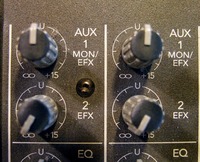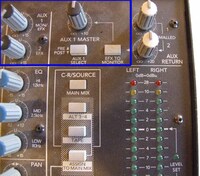Aux 1 and 2
 On each input strip are two knobs for Aux channels. Aux is like having a second mixing panel within your main panel. The Aux knobs determine how much signal from each input is sent to the main Aux Outputs.
On each input strip are two knobs for Aux channels. Aux is like having a second mixing panel within your main panel. The Aux knobs determine how much signal from each input is sent to the main Aux Outputs.
Traditionally, the Aux outs are used for providing a personalized monitor send to stage musicians (minus their own mics, but with the guide tracks needed to keep them in rhythm). Aux sends can also be used to send audio to special effects devices (echo, distortion, etc.). Aux sends can also provide separate mixdowns for live audience versus recording.
Some mixing boards offer more than just two Aux Channels. Concert boards may have 16 or even 32 Aux outputs; but two to four is most common on the smaller boards that we use for filmmaking.
Your Aux controls may be labeled, or have a switch, to determine if they function as Pre-Fader or Post-Fader.
 PRE FADER means that the signal is controlled by the Aux knob and is not affected at all by the fader. It is like having two separate mix boards.
PRE FADER means that the signal is controlled by the Aux knob and is not affected at all by the fader. It is like having two separate mix boards.
It is as if each mic were plugged into a "Y" cable, with one output going to the main mix and a separate output available to the Aux mix. Each set of controls is completely independent of the other. The main fader for the mic could be completely pulled down (in the off position) in the main mix, yet you could still send full volume out via the Aux mix.
For example, one mix could feed the PA system of an auditorium while the other mix could go out to the recorder. This would be handy when you don't want to have some mics generating loudspeaker feedback, or if some musical instruments were so loud that they didn't need to be amplified by the house speakers.
PA systems are more professionally referred to as Sound Reinforcement, because a house mixer's job is to amplify or reinforce the softer acoustic sounds in a live performance with the naturally louder sounds. For example, drums and horns are naturally loud, and would not require much amplification. But a flute or acoustic guitar would need help in order to not be completely drowned out on stage.
If you are videotaping a live event, be wary about recording the soundtrack provided directly from the "house" mixer. If they only provide you with a tap from the audience or "house" mix, you may discover that all of the loud instruments are lacking when you go to edit. Make certain that the house mixer knows the difference between giving you a complete mixdown (intended for recording) versus sound reinforcement for the audience live mix.
POST FADER means that the Aux knob takes effect after the signal has been controlled by the fader. If the fader were closed, then no signal would go to the Aux. The Aux output reflects any changes in volume made by the faders. But if the fader was open, and the Aux was closed, then no signal would go to the Aux output.
POST FADER Aux is used during production as a convenient way to send audio to the boom operator. Or to provide a monitor feed, say, to a viewing room.
For example, the output of all of the Aux 1 knobs is controlled by the Aux 1 Master knob. Use the Aux Master to control the volume of the boomperson's headphones.
If you have a tone generator plugged in to one of your inputs, then turn the Aux 1 knob down on that input so it won't blast the ears of your boom operator.
